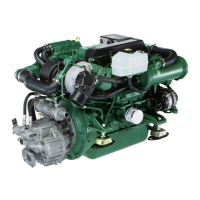General arrangement and planning
32
Selection of engine
suspension
There are two types of engine suspension; flexible
mounting with rubber mounts and rigid mounting.
Flexible mounting
One condition for rubber mounts to be effective damp-
ers is that the engine bed is sufficiently rigid. The bed
must also be parallel to engine feet to avoid tensions
being built into the engine suspension. Tensions can
increase the vibration level and also shorten the life
span of the mounts.
NOTE! The elasticity of the rubber mounts must never
be utilised to compensate for an inclined bed.
Flexible engine mountings provide good insulation
from vibration between the engine and the bed frame,
thus contributing to a low noise level. Dimensions for
flexible mountings, see page 40.
The rubber mounts are compressed during installation,
therefore the engine should rest on the rubber mounts
for 12 hours before the height is adjusted.
Always follow the recommendations of Volvo Penta
when selecting the engine suspension. The use of in-
correct rubber mounts can result in abnormal vibra-
tions, which in turn can cause damage to engine com-
ponents and also reduce the degree of comfort.
NOTE! When flexible engine suspension is selected,
all the connection of components to the engine must
be flexible. Also the propeller shaft must have a flexi-
ble stuffing box, or alternatively a flexible shaft cou-
pling.
The engine’s connections for fuel lines, exhaust and
coolant must be flexible.
Flexible engine suspen-
sion, rubber mount
Flexible engine suspen-
sion, rubber mount

